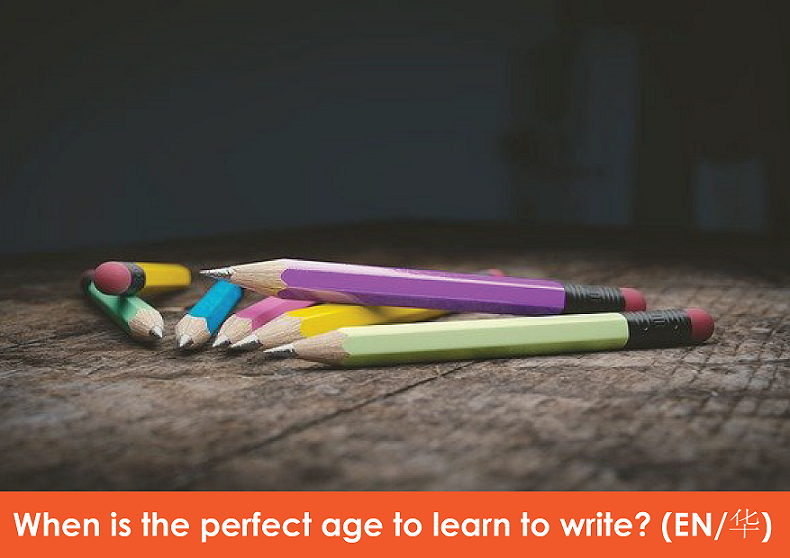
When is the perfect age to learn to write ?
The strength needed to learn to write mainly comes from the wrist and finger knuckles. Therefore, for children to write well, parents must first ensure that their bones are well developed and are able to support the strength needed for writing.
The ability to write does not solely affect children’s learning. In fact, there are many ways that children can learn without needing to write. Hence, getting children to learn to write and practise too much while they are still young is not a major priority.
It is not recommended for children to hold a pen to write before the age of 3. The most suitable age is actually after the age of 3, or even 4 years old. If the child’s bones are not mature yet but is forced to hold a pen for a long time, this can easily cause deformation in fingers or wrist. This will badly affect their fine motor skills development.
When will the child's arm muscles and knuckles be fully developed ?
It is probably between 7 and 9 years old. At this time, the wrist is stronger, and they do not feel tired easily or get sored hands. At this time, children can practice a lot more and not be worried about their skeletal development. Prior to this, of course, children can hold a pen to write, but not too long. You should always let their fingers do some form of different exercises so that the bones can move and will not be deformed due to long-term holding of the pen.
Also, parents must pay attention to your children’s sitting posture. Sitting posture also greatly affects children's future learning. Before adjusting children’s pen holding posture, parents can put more thoughts on the sitting posture. Skeletal deformities caused by poor sitting postures are difficult to remedy. However, whether the fonts are neat or not can be practiced diligently in the future after the bones are fully developed.
What activities can children under 3 years old do to assist in later writing training ?
If you want to lay a good foundation for children to write with a pen after the age of 3, parents have to spend a lot of time training their children's wrist and finger knuckles.
The simple activities that babies can do before the age of 3 are:
![]() Practice unscrewing the bottle cap (depending on the strength of the child, parents can loosen the cap slightly in advance)
Practice unscrewing the bottle cap (depending on the strength of the child, parents can loosen the cap slightly in advance)
![]() Rolling ball (rolling ball can train wrist and arm strength well)
Rolling ball (rolling ball can train wrist and arm strength well)
![]() Zipper (a simple zipper action is an effective activity for training finger muscles)
Zipper (a simple zipper action is an effective activity for training finger muscles)
![]() Coins (not only do coins help flex the finger muscles, but also improve the child's concentration and accuracy. These are greatly helpful to the writing training in the future)
Coins (not only do coins help flex the finger muscles, but also improve the child's concentration and accuracy. These are greatly helpful to the writing training in the future)
![]() Use your fingers to scribble and learn to write on some powder objects such as sand and salt (pour sand, salt or similar powder objects on a large plate, and let children write some words with their fingers, such as English letters. Such activities can make the child recognizes some simple words first without holding a pen)
Use your fingers to scribble and learn to write on some powder objects such as sand and salt (pour sand, salt or similar powder objects on a large plate, and let children write some words with their fingers, such as English letters. Such activities can make the child recognizes some simple words first without holding a pen)
![]() Stack building blocks, jigsaw puzzles, and do art and crafts (these seemingly ordinary educational activities/toys can help children develop their knuckles and wrists)
Stack building blocks, jigsaw puzzles, and do art and crafts (these seemingly ordinary educational activities/toys can help children develop their knuckles and wrists)
How can I help my child master the skills better when they just start learning to hold a pen after the age of 3 ?
At this age, the child’s finger muscles and joints are still developing and not fully mature. Parents are advised not to buy generic pencils. Generally, these pencils are too thin and too small, making it is difficult for children to hold them well, and it is also relatively uneasy for children to correct their pen holding posture. It is recommended that parents first introduce crayons, markers, and some larger pens, so that children can feel the pen holding posture and the angle of force. (These pens can also be used by children before they are 3 years old. Most of them are graffiti, so there is no need to correct the pen holding posture too harshly.)
In conclusion, it is good training for children to do more work. You will often see children who like to touch each other. In addition of bringing out their curiosity, touch is also one of the channels in which children begin to recognize the world. As long as it is still in a hygienic and safe condition, let the children touch more, do more with their hands, use fingers, wrists, and arm muscles appropriately! These are the key points for writing and practicing in the future. Once again, parents must remember not to blindly let their children learn to write with a pen. It does not mean that the earlier a child learns to write, the earlier the child starts to learn!
CLICK THE Link Below to WhatsApp Us Now or Call Us

宝宝应该几岁才适合学习写字,还没学习写字之前需要做些准备吗?或者需要注意些什么吗?
今天我们来了解关于宝宝练习写字的知识,希望对爸爸妈妈有帮助。
什么年龄适合学写字 ?
学写字需要的力度主要来自于手腕和手指指关节,所以要孩子写好字就得先确保孩子的骨骼已经发育成熟,有能力支持写字所需要的力度。
学会写字不代表孩子才开始学习,在不写字的情况下其实孩子可以学习的东西有很多,所以不要一昧地要求孩子学写字、练字。
3岁之前都不建议孩子握笔写字,最适合的年龄其实是在3岁之后,甚至到4岁也都还行。
如果孩子的骨骼在还没发育成熟却长时间握笔写字的情况下,是容易导致孩子手指变形,甚至是有畸形的倾向,然而这是会影响以后的各种发展,尤其需要手指活动的动作都会受影响。
孩子肢体的发育概况
孩子什么时候手臂肌肉和指关节发育健全?
大概是介于7至9岁之间,这个时候手腕比较有力,孩子不容易觉得握笔累或出现手酸的情况。
这时候练字练得多也比较不担心骨骼发育不健全。
在这之前,当然孩子是可以握笔写字的,只是时间不要太长,要时常让手指做一些不一样的运动,好让骨骼活动活动,不因为长期握笔定型的情况下而出现畸形。
还有,父母也得注意孩子的坐姿,坐姿也是大大影响孩子日后的学习。
在调整孩子握笔姿势之前,家长可以放多点心思在坐姿上。
不良坐姿带来的骨骼畸形是后天难补救的,然而字体是否工整待骨骼发育健全后还可以后天勤练。
如何帮助3岁前的孩子训练写字 ?
若想给孩子在3岁以后的握笔写字打好基础,父母们得花多点心思在训练孩子的手腕和手指指关节。
3岁以前宝宝们可以做的简单活动有:
![]() 练习拧开瓶盖 (视孩子的力度,父母可以事先把瓶盖稍微松开)
练习拧开瓶盖 (视孩子的力度,父母可以事先把瓶盖稍微松开)
![]() 滚球 (滚球的动作可以很好地训练腕力及臂力)
滚球 (滚球的动作可以很好地训练腕力及臂力)
![]() 拉拉链 (简单的拉拉链动作是训练手指肌肉的有效活动)
拉拉链 (简单的拉拉链动作是训练手指肌肉的有效活动)
![]() 投钱币 (投钱币的动作不但可以灵活手指肌肉,还可以提升孩子的专注力以及精准度,这些都是对往后写字训练有大大帮助的)
投钱币 (投钱币的动作不但可以灵活手指肌肉,还可以提升孩子的专注力以及精准度,这些都是对往后写字训练有大大帮助的)
![]() 在沙、盐等一些粉状物体上用手指涂鸦、学习写字 (把沙、盐或类似地粉状物体倒在大盘子,让孩子用手指写一些字,譬如英文字母,这样的活动可以让孩子在不需要握 笔的情况下先认识一些简单的字)
在沙、盐等一些粉状物体上用手指涂鸦、学习写字 (把沙、盐或类似地粉状物体倒在大盘子,让孩子用手指写一些字,譬如英文字母,这样的活动可以让孩子在不需要握 笔的情况下先认识一些简单的字)
![]() 叠积木、拼拼图、做美劳(这一些看似普通的益智活动/玩具都可以帮助孩子指关节和手腕发展)
叠积木、拼拼图、做美劳(这一些看似普通的益智活动/玩具都可以帮助孩子指关节和手腕发展)
如何帮助3岁后的孩子掌握技巧?
孩子在这个年龄手指肌肉、关节还是处于发育时期,未完全成熟,建议家长们不要买一般用的铅笔。
一般用的铅笔太细、太小,对孩子来说比较不容易握好,也相对难纠正孩子握笔的姿势。
建议家长先开始介绍蜡笔、麦克笔,一些比较粗大的笔,让孩子先感受一下握笔姿势和用力的角度。
(这一些笔也可以在孩子3岁前让他们尝试使用,多为涂鸦,不必过分严苛地纠正握笔姿势。)
总结: 让孩子多动手是很好的训练
你会常常看到孩子喜欢东摸西摸的,除了出于好奇以外,触摸也是孩子开始对这个世界产生认知的其中一个管道。
只要还处于卫生、安全的情况下,让孩子多触摸、多动手、适当的使用手指、手腕、手臂的肌肉吧!
这些都是日后写字、练字的关键点。
再次强调,父母们切记不要盲目地让孩子学习握笔写字,不是孩子越早学会写字才代表孩子开始学习哦!
CLICK THE Link Below to WhatsApp Us Now or Call Us



